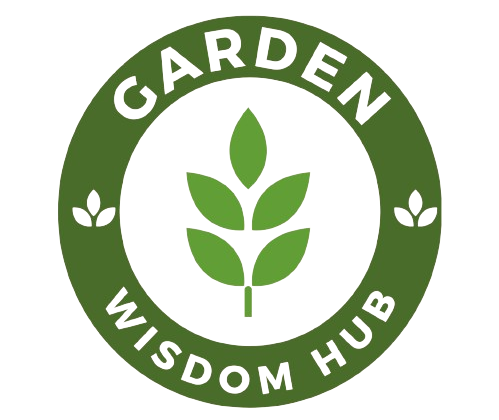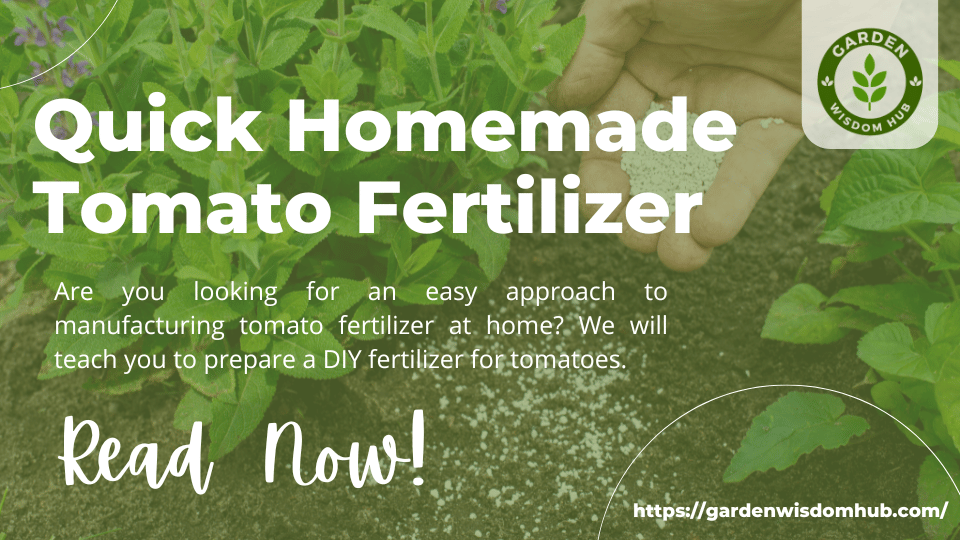This article contains links to products from which I may earn a commission.
Quick homemade tomato fertilizer for the vegetable garden:
Are you looking for an easy approach to manufacturing tomato fertilizer at home? We will teach you to prepare a DIY fertilizer for tomatoes. You might wonder why use a homemade tomato fertilizer. This simple formula will grow tomato plants quickly. Nothing beats seeing your first tomato blossom in your yard. It means sun-ripe tomatoes are coming!
These cute little fruits in red, yellow, purple, and green are more than they appear. They represent months of hard effort and perseverance to raise them. Even if you take good care of your plants, poor soil might lead to a dismal crop. This is where fertilizers help.
Sustainable DIY tomato fertilizer is appealing, especially with the variety of commercial solutions. This strategy saves money and is eco-friendly. It also ensures that the soil is organic, natural, and chemical-free. Let’s explore homemade tomato fertilizers, their benefits, what tomatoes want, and a dependable recipe to get started.
Effective Organic Fertiliser for Healthy Plants:
With a 2-5-3 NPK creation and 4 pounds of nutrient-rich grains, Jobe’s Natural Compost encourages extraordinary yields and beautiful leaves in tomatoes and vegetables. It’s easy to apply each 4 a month and a half and is OMRI-listed, liberated from manufactured synthetic compounds. Strong root improvement and supported supplement discharge are upheld, making it ideal for various plants and gardens.
Highly Recommended This Products!
Why Use a Homemade Tomato Fertilizer?
When you make your own, you control what goes into your garden and on your plate. DIY tomato fertilizer has many benefits:
The Epitome of Sustainability:
Making your fertilizer from everyday things or garden trash is good for the environment and promotes sustainable farming. We reuse organic waste like banana peels and eggshells to avoid waste.
Healthier Plants and Produce:
Commercial fertilizers include several chemicals. They may claim speedier results, but they can harm soil microbes. Natural tomato fertilizers improve soil conditions, promoting plant development and healthier tomatoes. Gardening is expensive, especially with the constant need for fertilizers.
With a few items from home or the yard, you can offer your plants the greatest care without breaking the budget. Homemade solutions are fantastic since you can customize them. Talk to your tomato plants to find out what they need, then change your fertilizer recipe based on your soil test or development stage. Making your mix ensures that you’re getting a real organic product, unlike many products that claim to be “organic.” This benefits the soil and plants and ensures that your food is natural and additive-free.
Simple pH Testing for Growers:
With the help of the 3-in-1 Soil Tester, cultivating should be possible all the more definitively by estimating soil moisture, light, and pH levels. Its 10.8-inch size makes it compact and small. It has a pH size of 3.5-8, a light power scope of 0-2000, and a moisture scope of 1-10. Plug in and read no batteries are required. Ideal for cultivating both inside and outside.
Highly Recommended!
What Tomato Plants Need for Optimal Growth and Health:
Tomatoes, like any other plant, thrive in the correct nutrients. Good nutritional balance is needed for tomato plants to thrive and crop well. Homemade fertilizer for tomatoes in containers is also required.
Homemade nitrogen for tomato plants
Nitrogen (N), also known as the ‘leaf nutrient’, is essential for plant growth. It keeps tomato plants healthy and gives them that brilliant green color we adore. However, much nitrogen, especially while fruiting, might cause leaf overgrowth but decreased fruit production.
Natural phosphorus for tomatoes:
An essential ingredient for energy transfer and flower and fruit development. Phosphorus is essential for tomato plants to generate many flowers and a successful yield.
Potassium (K), the ‘quality nutrient’, affects several physiological processes in plants and helps them stay healthy. In addition to protein production, it helps plants resist drought and infections. Potassium is known to boost tomato growth, color, and flavor.
Secondary macronutrients:
Calcium (Ca):
Essential for cellular growth, calcium prevents tomato blossom end rot.
Magnesium (Mg):
Chlorophyll contains magnesium, which is essential to photosynthesis. It guarantees lush greenery and improved photosynthetic performance.
Sulfur (S):
This nutrient is necessary for amino acid synthesis and plant protein growth.
Micronutrients:
Plants need trace elements like iron, manganese, zinc, molybdenum, boron, and copper for enzymatic and physiological functions.
Application:
Sprinkle bone meal on top of the soil. Just gently work it in, and you’re done! Too much can make the soil too alkaline, so keep to the amounts. The bone meal I recommend is this. Tomato plants benefit from wood ash. It boosts plant health by supplying calcium and potassium to the soil.
Sprinkle a little wood ash at the base of your tomato plants. Rake it into the soil. Crushed eggshells, heavy in calcium, can prevent tomato blossom end rot. After washing and drying the eggshells, crush them into a fine powder. This can be sprinkled around tomato plants or mixed into the soil. I recommend this excellent powder.
Advantages:
Compost tea improves soil health and provides critical nutrients. Additionally, it boosts soil microbes. Fill a large bucket with compost. Then, thoroughly water it. Let it sit, stirring occasionally. Separate the solids and hydrate tomatoes with the liquid.
Homemade liquid fertilizer for tomatoes recipe:
Do you Need a simple tomato fertilizer recipe? Look no further! Try this easy DIY tomato fertilizer recipe.
I have a tomato fertilizer recipe that uses many of the ingredients you mentioned:
- 1 tablespoon Epsom Salt
- 4-5 eggshells
- 2 tablespoons Bone Meal
- 1 tablespoon Baking Soda
- and 1-gallon water.
Powerful Muscle Ache Help with Epsom Salt:
With this pharmacy-quality pure Epsom salt, you may effectively ease distress and muscular aches. Superfine, aroma-free salt crystals break up quickly in water. Before heading to sleep, absorb two cups of steaming shower water for twenty minutes. Never tried on creatures, it is liberated from parabens and phthalates.
Highly recommended for a calming, straightforward Epsom salt experience!
Instructions:
Rinse your eggshells:
It will remove any egg residue before making eggshell powder. Let them breathe. Crush the shells into a fine powder after drying. Use a mortar and pestle or coffee grinder if you have one. Did you know eggshells are calcium-rich? This vitamin helps tomatoes avoid blossom end rot.
Mix dry ingredients:
In a large bucket, mix powdered eggshells, Epsom salt, bone meal, and baking soda. Epsom salt gives plants magnesium and sulfur, while bone meal gives them phosphorus and calcium. Don’t forget baking soda, which can prevent garden illnesses.
Mix with water:
Add the gallon of water to your dry ingredients and whisk regularly to dissolve and mix. This procedure keeps the mixture safe for plants.
Use:
Water tomato plants at the base, avoiding the foliage. Use it every 4-6 weeks throughout your plants’ peak growing season.
Storage:
If you have extra fertilizer, find a cool, dark area to keep it. To ensure all components are blended, shake it thoroughly before using. With this fertilizer, your tomato plants will get all the nutrients they need to thrive and harvest well. It’s like feeding them a balanced diet to grow big and robust. Have fun gardening.
Conclusion: Quick Homemade Tomato Fertilizer
This strategy saves money and is eco-friendly. It also ensures that the soil is organic, natural, and chemical-free. Let’s explore homemade tomato fertilizers, their benefits, what tomatoes want, and a dependable recipe to get started.
Do not forget to check out our other articles for detailed and comprehensive knowledge:
- Coffee Grounds Good for Tomato Plants
- When to Start Tomato Seeds Indoors
- Art of Harvesting Tomatoes
- Best Companion Plants for Tomatoes
- Grow Tomatoes Anywhere with Grow Bags
- Leggy Tomato Seedlings
Frequently Asked Questions: Quick Homemade Tomato Fertilizer
Can coffee grinds fertilize tomato plants?
Of course! Coffee grounds do add nitrogen to tomato plants. To avoid soil acidity changes, use them sparingly and compost them.
How often should tomato plants receive homemade fertilizer?
Fertilize your plants every 4-6 weeks while they’re growing. Fertilizing plants requires caution. Avoiding danger requires following the prescribed amounts.
How can I detect if my tomato plants require nutrients?
Some plants’ leaves become yellow, indicating they need extra nitrogen. Another symptom is blossom end rot, which is often caused by calcium deficiency. Your fruits may be underdeveloped due to phosphate or potassium deficits.
Can we use Fish emulsion on immature tomato plants?
Of course! Young plants benefit greatly from fish emulsion fertilizers. To avoid root damage, follow the instructions and dilute it correctly.
What fertilizers should I avoid for tomato plants?
Manure can benefit your plants, but it must be well-composted. This will prevent unwanted germs from entering and protect your plants from nitrogen burns.
James Porter
Welcome to our haven of gardening and plant care, where outdoor and indoor planting enthusiasts come together! At Gardening Wisdom Hub, we aim to provide you with the most authentic information on anything related to gardening, plant care, seasonal planting etc.
The author of our website is James Porter, an experienced industry veteran. He has a deep interest in everything green. James’s enthusiasm for exploring plants’ features and learning new gardening methods began at a young age. Gradually, his passion increased with time, leading him to become a highly esteemed professional. His extensive knowledge makes him a priceless resource for inexperienced and seasoned gardeners.

